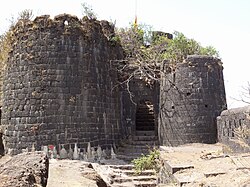Purandar
| Purandar | ||
|---|---|---|
|
|
||
| State : |
|
|
| State : | Maharashtra | |
| District : | Pune | |
| Location : | 18 ° 17 ′ N , 73 ° 59 ′ E | |
| Height : | 700 m | |
| Residents : | 500 | |
| Purandar Fort - gate system | ||
Purandar or Purandhar ( Marathi : पुरंदर किल्ला) is a small Indian village with about 500 inhabitants in the state of Maharashtra . In the 17th century, the high fortress ( Purandar Fort ) located on a mountain about 1475 m high above the village played a not insignificant role in the dispute between the Marathas and the Mughal Empire .
location
The village of Purandar is located on the east side of the elongated mountain range of the Western Ghats ( Sahyadri Range ) at an altitude of approx. 700 m above sea level. d. M. about 50 km southwest of the city of Pune .
economy
The residents of the village live from agriculture - mostly self-sufficient . Tourism hardly plays a role.
history
The history of the place goes back to the 11th century; A medieval temple in the neighboring village of Narayanpur dates from this time. Around 1350 the mountain was fortified by invaders from Persia by a two-part fort, which was repeatedly besieged in the 14th and 15th centuries. In 1490 the fort came under the rule of the Deccan sultanate of Berar , which was legally incorporated into the Mughal Empire in 1596 , but in fact formed one of the pillars of the later Marathas Empire under Shivaji . This seized the fort in 1646; his son Sambhaji was born here in 1657. Eight years later, the fortress was taken by the troops of the Grand Mughal Aurangzeb under the leadership of the Rajput general Man Singh of Amber . In the same year (1665) Shivaji concluded a peace treaty with Aurangzeb, which, however, did not last long, because in 1670 he recaptured the mountain fort from the hands of the Mughals.
After the gradual collapse of the Mughal Empire, the British took power towards the end of the 18th century and hoisted their flag in the fort in 1818. At first a garrison was stationed, but around the middle of the 19th and first half of the 20th century they operated a hospital for sick soldiers there. During the Second World War , an internment camp for German citizens was set up in the fortress .
Attractions
The most important sights within the two-part fort area ( Vajragad and Rudramal Fort) are the gate system ( Dilli Darwaza ) flanked by two round towers , an open cistern ( Padamvati Tank ), the colonial church with a small bell gable and several small and sometimes brightly painted Hindu temples . When the view is clear, the ascent to the fort and the views over the surrounding landscape are quite impressive.
Web links
- Purandar Fort - Photos + Info (English)
- Purandar Fort - Photo + Info (English)


